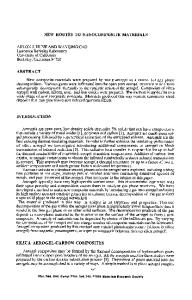A new route to bulk nanocrystalline materials
- PDF / 156,751 Bytes
- 4 Pages / 612 x 792 pts (letter) Page_size
- 88 Downloads / 386 Views
Despite their interesting properties, nanostructured materials have found limited use as a result of the cost of preparation and the difficulty in scaling up. Herein, the authors report a technique, friction stir processing (FSP), to refine grain sizes to a nanoscale. Nanocrystalline 7075 Al with an average grain size of 100 nm was successfully obtained using FSP. It may be possible to further control the microstructure of the processed material by changing the processing parameters and the cooling rate. In principle, by applying multiple overlapping passes, it should be possible to produce any desired size thin sheet to nanostructure using this technique. We expect that the FSP technique may pave the way to large-scale structural applications of nanostructured metals and alloys.
Numerous investigators have demonstrated the considerable advantages in mechanical properties of nanostructured materials over conventional coarse-grained structures. However, the transition from laboratory experiments to practical application has been slow because it is relatively easy to synthesize powders and produce small samples with nanoscaled structures, but it is much more difficult to obtain the same materials in large-scale bulk forms for structural applications. Development of processing techniques that enable the production of bulk nanostructured materials large enough for many engineering applications is essential. A new processing technique, friction stir processing (FSP), has recently been developed by adapting the concepts of friction stir welding.1 This technique (Fig. 1) involves plugging and traversing a cylindrical rotating tool through a material to produce intense plastic deformation. Localized heating is produced by severe plastic deformation of the material and the friction between the rotating tool shoulder and the top surface of the base metal.2 This new thermomechanical processing technique has been found to be an effective grain refinement technique for aluminum alloys.2–6 The finest grain size obtained in a previous study has been reported to be 0.5 m.6 Given the nature of the process and the mechanisms behind the microstructural evolution,7 we hypothesized that by combining this technique with rapid cooling, it should be possible to produce large-scale nanocrystalline materials.
a)
Address all correspondence to this author. e-mail: [email protected] J. Mater. Res., Vol. 18, No. 8, Aug 2003
Commercial 7075 Al sheet, 2-mm thick, was selected for this investigation. A single-pass frictionstir-processed zone 20-cm long was produced at a travel speed of 12 cm/min and a rotational speed of 1000 rpm. A mixture of water, methanol, and dry ice was used to quench the plate immediately behind the FSP tool. Transmission electron microscopy (TEM) observation of the postprocessed microstructure supported the authors’ hypothesis. Figure 2 shows the typical microstructure observed in the 7075 Al in the asprocessed condition, together with a select area diffraction (SAD) pattern, taken from a 1.7 m diameter region. The pa
Data Loading...










